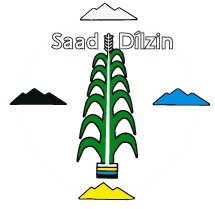Introduction to Navajo Questions
Any competent speaker of any language will be able to form questions. This resource is a combined grammar and lexicon of Navajo questions. We provide a description of three kinds of questions along with glossed examples and audio recordings of them. We think this resource will be useful to students and teachers of this language, and to professional linguists within and outside Navajo communities.
We distinguish three distinct kinds of questions: Yes/no questions, Content Questions, and Alternative Questions. We treat Tag Questions as a subtype of Yes/no questions. For this project we draw on previous work by Fernald & Perkins (manuscript), Young & Morgan (1987), Young, Morgan & Midgette (1992), and others cited in References [link].
| Da’ | Na’nízhoozhígóó | díníyá? |
| Q | Gallup-to | 2-go.F |
| Are you going to Gallup? | ||
| Mary | ha’át’íí | nayiisnii’? |
| Mary | what | 3-3-buy.P |
| What did Mary buy? | ||
| ’Atsį́’ísh | ’éí | doodaii’ | łóó’ísh | nínízin? |
| meat-Q | TOP | or | fish-Q | 3-2-want.NI |
| Do you want meat or fish? | ||||
Example (1) is a yes/no question, which has ‛yes’ or ‛no’ as an answer. Questions like this are used to ask whether a particular statement is true or not. In this example, the statement being asked about is Na’nízhoozhígóó díníyá, which means ‛You are going to Gallup’.
Content questions, like example (2), do not have simply ‛yes’ or ‛no’ as an answer. Rather than supplying a statement and asking whether it is true or not, they have the effect of providing a statement with some missing information, and they ask what that information is. In (2), the idea is that Mary bought something, and the question asks what that something is.
Alternative questions present the addressee with a choice between two or more options. Note that the English gloss in example (3) can be understood as either a yes/no question (if the intonation is rising on fish) or an alternative question (if the intonation is falling on fish). In Navajo, the sentence is an alternative question for which the appropriate answer will indicate which one of the choices is desired.
Glossing conventions and a note on morphology are here [link].
Ła’ ha’nitáhígíí ’éí biihidzóhí 50 entries
ʼÁłah ʼaleehdi ʼamá bééhániih daats'í bá ’ádazhniiyą́ą́’? ʼÁko daatsʼí nímasii łaʼ ʼakǫ́ǫ́ dííkááł.
group gathering-at mother 3-3-remember perhaps 3-for 4-pl-eat.P so perhaps potatoes some there 3-2-take.OC.FCh’ah ’éí doodaii’ nák’ee sinilí łizhinígíí daats’í nee hólǫ́’?
hat or sunglasses perhaps 2-with 4-exist.NIChidíísh bee hólǫ́ ’éí doodago ni daats’í ła’ nee hólǫ́?
car-Q 3-with 4-exist.N TOP or 2 maybe one 2-with 4-exist.NIDa’ Ron saad neiskáá’?
Q Ron word 3-3-investigate.PDah díníilghaazhísh ’íilnilaa?
fry.bread-Q 3-2-make.PDaniel hahgosh hidilníísh?
Daniel when-Q 3-start.work.IDichin nínízin ya’?
hungry 2-want.NI QDíí chąą’ shą’ háádę́ę́’ niníyęęzh?
this manure-Q where-from 3-ooze.PDíí chąą’ shą’ háádę́ę́’ niníyęęzh?
this manure-Q where-from 3-ooze.PDíí haa yit’éego ’atiin?
this how 3-be.NI roadDíkwíí jį́ nanilnish?
how.many-Q day 2-work.IDíkwíí jį́ shą’ nanilnish?
how.many Q days 2-work.IDíkwíí shą’ ninááhai?
how.many Q 2-winter.NIDíkwííshą’ nibeegashii?
how.many-Q 2-cowDíkwíí lá ninááhai?
how.many Q 2-winterGohwééh t’áá bizhání ’éí doodaii’ ’abe’ biłgo daats’í nínízin?
coffee only TOP or milk perhaps 3-with 3-2-want.NIHa’át’éego lá ’íiyisíí ’atiinjį’ ’ańdeeshdááł lá?
how Q main road-up.to 1-back-on-go.F DISCHa’át’éegosh náníldzid?
why-Q 2-fear.IHa’át’éegoshą’ t’áadoo díníyáa da?
why-Q neg 2-go.sg.P NEGha’át’éégóó
Ha’át’íí biniinaa náníldzid?
what 3-cause 2-fear.IHa’át’íí biniiyé shą́ą́h ńdídááh?
what 3-because 1-passing.by 2-go.IHa’át’íí shį́į́ biniinaa łeech’ąą’í nidahał’in?
what perhaps 3-because dog pl-3-bark.IHa’át’íí shį́į́ biniinaa łééch’ąą’í nidahał’in.
what perhaps 3-because dog pl-3-bark.IHa’át’íísh baa hane’?
What Q 3-for be.told.CIHa’át’íísh neidiyoołnih nínízin?
who-Q 3-3-buy.F 2-think.NIHa’át’ííshą’ hastiin dóó ’at’ééd ’áyiilaa?
what-Q man and girl 3-3-make.PHa’át’íí́sh baa hane’?
What Q 3-for be.told.CIHaa nízahdę́ę́’ hoołtį́į́ł?
how 3-long-from rain.ProgHahgo hooghan ’ánílééh?
when hogan 3-2-make.IHádą́ą́’ hooghan ’ájíilaa?
When-past this hogan 3-4-make.PHádą́ą́’ Jáan Tó Hónaanígóó naayá?
When past John ocean across-to 3-go.PHáí lá kintahgóó shił adoołbąs?
who-Q town-to 1-me 3-drive.FHáí shą’ ’ałhosh?
who Q 3-sleep.IHáísh ’átsą́ą́’ jóyą́ą́’ laanaa nízin?
Who ribs 4-eat.O hope 3-3-want.CIJáan, nanilnishísh?
John 2-work.I-QMary hádą́ą́’sh ’ólta’dę́ę́’ nádzá?
Mary when-past-Q school-from 3-return.PNa’nízhoozhígóó deeyá, ya’?
Gallup-toward 2-go.sg.F QNa’nízhoozhígóó náádínídzáago háadish ’adeeshį́į́ł nínízin?
Gallup-toward again-2-go.R-GO where-Q 1-eat-F 2-want.NIbee ’ééhóziní
- ’Ánáhoot’įįhígíí’áhát’íní hoolzhishgi bik’ídáahgi
- yishááh go’áhát’íní hoolzhishgi bik’ídáahgi
- Náásgóó’áhát’íní hoolzhishgi bik’ídáahgi
- ’ashą́ eat’áhát’íní hoolzhishgi bik’ídáahgi
- háá-P.ENCLITIC where
- -góó to, toward, along, on, with a numeral it indicates a date’akéé’ si’ání zanoo’į́ bik’ídáahgi




